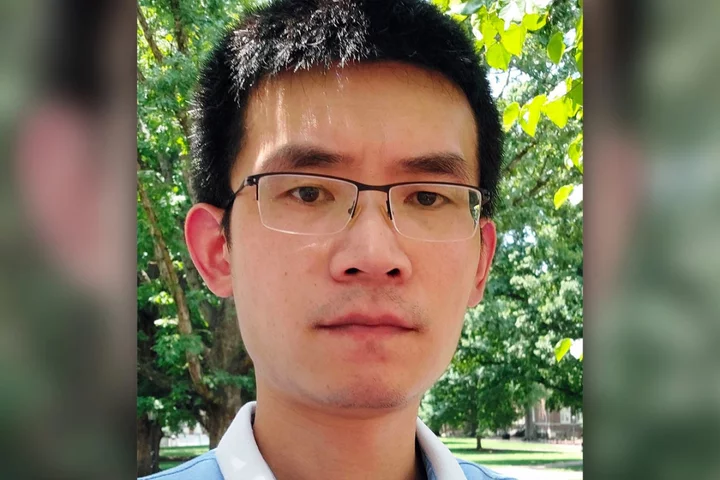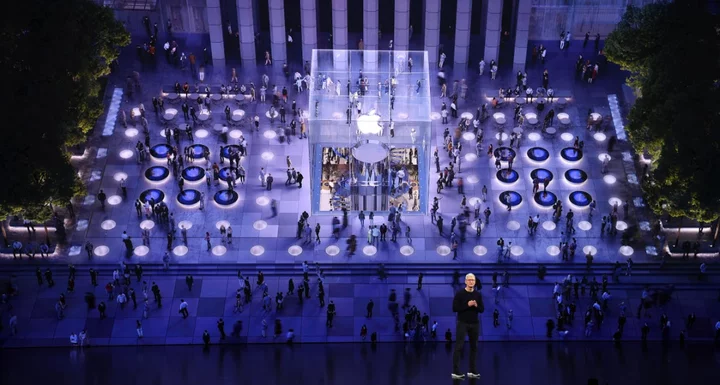
World’s largest crypto exchange pays $4.3bn to settle federal cases as CEO resigns
Binace, the world’s largest cryptocurrency exchange, will pay over $4bn to US officials after admitting to unlicensed money transfers, sanctions violations, and willfully failing to institute anti-money laundering protections, federal officials announced on Tuesday. The oversights allowed trading with sanctioned nations like Iran, Cuba, and Syria, and failed to institute systems to report suspicious potential transactions with terror groups, according to the Treasury Department. “Binance was allowing illicit actors to transact freely, supporting activities from child sexual abuse to illegal narcotics to terrorism,” Treasury Secretary Janet Yellensaid on Tuesday. Changpeng Zhao, the founder of and CEO of Binance, is also stepping down, and will pay a $50m fine after pleading guilty to related charges. He could face up to 18 months in prison. “I made mistakes, and I must take responsibility,” the executive wrote on X. “This is best for our community, for Binance, and for myself.” Federal officials described a wide-ranging set of problems at the crypto exchange, which at times handled two-thirds of global crypto trades. “It willfully enabled hundreds of millions of dollars in transactions between American users and users subject to US sanctions,” US Attorney General Merrick Garland said in remarks on Tuesday. “And its platform accommodated criminals across the world who used Binance to move their stolen funds and other criminal proceeds. “Binance prioritized its profits over the safety of the American people.” The massive penalty, one of the largest in US financial regulation history, will also go towards resolving inquiries from the Commodity Futures Trading Commission, the Department of the Treasury’s Financial Crimes Enforcement Network (FinCen), and the Office of Foreign Assets Control. On multiple occasions, Binance leadership intentionally took steps that allowed dangerous and illegal transactions to take place, according to the Justice Department. Binance knew it served US customers, meaning it had to register with FinCen and implement anti-money laundering controls, but “chose not to comply,” per the DOJ. Rather than set up these protections, the company created a separate Binance.US platform in 2019, while seeking to encourage VIP customers to obscure their accounts and continue using the main exchange, officials said. “Binance executives, including Zhao, made a plan to contact VIP customers and help the VIP register a new account for an offshore entity and transfer holdings to that account,” the DoJ said in an announcement of the agreement on Tuesday. “Binance employees also called US VIPs to encourage them to provide information that suggested the customer was not located in the United States.” The company, knowing it had US customers, also failed to introduce controls that would stop them from making trades with sanctioned jurisdictions like Iran, resulting in over $898m in trades between US and Iran-based users between January 2019 and May 2022. At one point, according to the DoJ, Zhao told employees it was “better to ask for forgiveness than permission,” while in another instance, a compliance employee wrote in a message, “We need a banner ‘is washing drug money too hard these days - come to binance we got cake for you.’” In a statement on Tuesday, Binance acknowledge making “criminal violations.” “These resolutions acknowledge our company’s responsibility for historical, criminal compliance violations, and allow our company to turn the page on a challenging yet transformative chapter of learning and growth,” the company wrote. “With the compliance and governance enhancements enshrined in our commitments, we can begin to share our vision for Binance’s exciting future and the future of the crypto industry.” The company also emphasised that the resolutions don’t allege Binance misappropriated user funds or engaged in market manipulation. Richard Teng, the company’s former global head of regional markets, will take over as CEO, according to Binance. The massive agreement with federal regulators will also require Binance to accept the appointment of a government monitor to oversee the business and bar Zhao from involvement with the company until three years after the monitor is appointed, according to court records viewed by The New York Times. Notably, the Securities and Exchange Commission was not a part of the Binance agreement. The SEC sued Binance and Zhao in June, alleging that they used companies beneficially owned by Zhao to inflate trading prices and make money off customers, allegedly mixing customer funds with Binance money. “While we take the SEC’s allegations seriously, they should not be the subject of an SEC enforcement action, let alone on an emergency basis. We intend to defend our platform vigorously,” the company responded at the time in a statement. “And, to be clear: any allegations that user assets on the Binance.US platform have ever been at risk are simply wrong, and there is zero justification for the Staff’s action in light of the ample time the Staff has had to conduct their investigation,” the company added in the statement. The massive settlement comes just weeks after FTX founder Sam Bankman-Fried was found guilty in federal court of defrauding customers on his popular cryptocurrency exchange out of billions of dollars. Bankman-Fried’s defence team has vowed to fight the charges.
2023-11-22 10:51

Crypto firm Tether says it has frozen $225 million linked to human trafficking
By Elizabeth Howcroft LONDON Crypto firm Tether said on Monday that it had frozen $225 million worth of
2023-11-21 00:23

FBI steps up search for members of cybercrime group 2 years after announcing it had taken its systems down
The FBI has stepped up its search for members of a multimillion-dollar cybercrime group more than two years after the bureau and its European allies announced they had taken down the group's computer systems, according to newly unsealed court documents reviewed by CNN.
2023-09-23 02:15

Wrongly arrested because of facial recognition: Why new police tech risks serious miscarriages of justice
On 16 February, Porcha Woodruff was helping her children get ready for school when six Detroit police officers arrived at her door. They told her she was under arrest for a January carjacking and robbery. She was so shocked she wondered for a moment if she was being pranked. She was eight months into a difficult pregnancy and partway through a nursing school programme. She did little else besides study and take care of her kids. She certainly wasn’t out stealing cars at gunpoint, she said. “I’m like, ‘What,?’ I opened my door so he could see my stomach. ‘I’m eight months pregnant. You can see two vehicles in the driveway. Why would I carjack?’” she told The Independent. “‘You’ve gotta be wrong. You can’t have the right person.’” Her children cried as she asked officers if the suspect was pregnant and insisted they had mistakenly arrested her. She was put in handcuffs and taken to jail, where she had panic attacks and early contractions. She later learned police identified her as a suspect after running security footage through the department’s facial recognition software, relying on a 2015 mugshot from a past traffic arrest into a photo lineup where the carjacking victim singled out Ms Woodruff as her assailant. The Detroit Police Department eventually dropped the case, but the arrest has deeply shaken Ms Woodruff. “What happened to the questioning? What happened to me speaking to someone?” she said. “What happened to any of the initial steps that I thought were available to a person who was accused of doing something?” The case underscores the growing risks of civil rights violations as police departments and law enforcement agencies across the country increasingly adopt facial-recognition and other mass surveillance technologies, often used as an unreliable shortcut around methodical human police work. Criminal justice advocates and the people targeted by this burgeoning police tech argue these programmes are riddled with the same biases and opaque or nonexistent oversight measures plaguing policing at large. The early results, at least, haven’t been encouraging. At least six people around the US have been falsely arrested using facial ID technology. All of them are Black. These misfires haven’t stopped the technology from proliferating across the country. At least half of federal law enforcement agencies with officers and a quarter of state and local agencies are using it. “We have no idea how often facial recognition is getting it wrong,” Albert Fox Cahn, executive director of the Surveillance Technology Oversight Project (STOP), told The Independent. “When you have facial recognition being used thousands of times, without any accountability for mistakes, it’s inviting injustice,” he added. Nowhere has that injustice been more pronounced than Detroit, a city where Black people have long experienced documented over-policing from law enforcement. Three of the six people mistakenly arrested by facial recognition technology have been in the Motor City, according to the ACLU. This status quo is why Ms Woodruff is suing DPD, claiming among other things that the agency has engaged in “a pattern of racial discrimination” against her and other Black residents “by using facial recognition technology practices proven to misidentify Black citizens at a higher rate than others in violation of the equal protection guaranteed by” the Michigan civil rights statutes. “I definitely believe that situation would’ve gone differently had it been another race, honestly, just my opinion. There was no remorse shown to me and I was pregnant. I pleaded,” she told The Independent. “Being mistaken for something as serious as that crime – carjacking and armed robbery – that could’ve put me in a whole different type of lifestyle,” she added. “I was in school for nursing. Felons cannot become nurses. I could’ve ended up in jail. That could have altered my life tremendously.” The Independent has requested comment from DPD. After Ms Woodruff filed her suit, Detroit police chief James White said in a press conference in August “poor investigative work” led to the false arrest, not facial recognition technology. He claimed that department software gave detectives numerous possible suspects and was only meant to be a “launch” point for further investigation. “What this is, is very, very poor investigative work that led to a number of inappropriate decisions being made along the lines of the investigation, and that’s something this team is committed to not only correcting, having accountability, having transparency with this community, and in building policy immediately to ensure regardless of the tool being used, this never happens,” Mr White said. He added that officers won’t be allowed to use images sourced by facial recognition in lineups, and warrants based on facial ID matches must be reviewed by two captains before being carried out. ‘The lead and the conclusion’ Some aren’t convinced these changes will prevent the excesses of what they see as a fundamentally flawed technology. “The technology is flawed. It’s inaccurate,” Philip Mayor, senior staff attorney at the ACLU of Michigan, told The Independent. “Police repeatedly assured us that it’s being used only as an investigative lead, but what we see here in Detroit time and time again is it is both being used as the lead and the conclusion.” Studies suggest that facial-recognition algorithms, which have been used to capture suspects in high-profile cases like those connected to January 6, also fail to accurately identify Black people and women, driving up inequalities in arrests, because image-training datasets often lack full diversity. However, according to Mr Mayor, police departments make things even worse by failing to do basic training and common-sense investigative work on top of facial recognition tools. He represents Robert Williams, a Detroit man who was mistakenly arrested for a 2020 theft from a high-end Detroit boutique. A security contractor employed by the store worked with the city and state police and flagged Mr Williams’ name using facial recognition tools. How police came to trust that Williams was the right man reveals the sloppiness of how facial ID tech is used in practice, according to the ACLU attorney. After the theft, police searched a database containing both past photos of Mr Williams and his present-day driver’s license. ‘It picks out 486 people who are the most likely perpetrators; not a single one of them is his current driver’s license, even though his current driver’s license is in the database that was searched,’’ Mr Mayor said. “That seems like an obvious exculpatory fact, the kind of thing that would lead you to say if you were actually thinking, this isn’t the right guy.” When these dubious matches are then used to build a line-up, questionable police work attains the gloss of near-fact, and witnesses choose from a group of people who may have no credible tie to a crime that took place but still look something like the person who did. “This is not me,” Mr Williams told police during his investigation, according to The New York Times. “You think all Black men look alike?” The father of two, after asking a local police voluntarily stop using facial recognition technology, sued the DPD in 2021. “This technology is dangerous when it doesn’t work, which is what the cases in Detroit are about. It’s even more dangerous when it does work. It can be used to systematically surveillance when we come and go from every one of the places that are important in our private lives,” the ACLU attorney said. “I don’t think there’s any reason to believe that departments elsewhere right now are not making the same mistakes.” ‘A force multiplier for police racism’ Detroit isn’t the only place grappling with the impacts – and errors – of this technology. In Louisiana, the use of facial recognition technology led to a wrongful arrest of a Georgia man for a string of purse thefts. A man in Baltimore spent nine days in jail after police incorrectly identified him as a match to a suspect who assaulted a bus driver. The Baltimore Police Department ran nearly 800 facial recognition searches last year. Those cases and others have added to a growing list of misidentified suspects in a new era of racial profiling dragnets fuelled by tech that is rapidly outpacing police and lawmakers’ ability to fix it. Facial recognition software often is “a force multiplier for police racism,” worsening racial disparities and amplifying existing biases, according to Mr Cahn. It can spur a vicious cycle. Black and brown people are already arrested at disproportionate rates. These arrests mean they are more likely to enter a database of faces being analyzed and used for police investigations. Then, error-prone facial recognition technology is used to comb these databases, often failing to identify or distinguish between Black and brown people, particularly Black women. “So the algorithms are biased, but that’s just the start, not the end of the injustice,” Mr Cahn says. Such technologies, advocates warn, are embedded in wider mass surveillance programmes that often lack robust public oversight. In New York City, law enforcement agencies relied on facial recognition technology in at least 22,000 cases between 2016 and 2019, according to Amnesty International. New York City’s Police Department spent nearly $3bn growing its surveillance operations and adding new technology between 2007 and 2019, including roughly $400m for the Domain Awareness System, built in partnership with Microsoft to collect footage from tens of thousands of cameras throughout the city, according to an analysis from STOP and the Legal Aid Society. The NYPD has failed to comply with public disclosure requirements about what those contracts – from facial recognition software to drones and license plate readers – actually include, according to the report. Until 2020, that money was listed under “special expenses” in the police budget until passage of the Public Oversight of Surveillance Technology Act. The following year, more than $277m in budget items were listed under that special expenses programme, the report found. “We’ve seen just concerted pushback from police departments against the sort of oversight that every other type of government agency has because they don’t want to be held accountable,” according to Mr Cahn. “If we treated surveillance technology vendors the way we treated other technology vendors, it would be like Theranos – police would be arresting some of these vendors for fraud rather than giving them government contracts,” he added. “But there is no accountability.” On 7 August, 2020, New York City Police Department officers in riot gear launched a six-hour siege outside Derrick Ingram’s Hell’s Kitchen apartment. Mr Ingram – a racial justice organiser who is embroiled in a federal lawsuit against the NYPD – was surrounded by more than 50 officers after he allegedly shouted into an officer’s ear at a protest earlier that summer. Police insisted they had a warrant on assault charges, but couldn’t produce one when Mr Ingram asked them to, according to his suit. The whole encounter, in which the NYPD deployed snipers, drones, helicopters, and police dogs, began with facial recognition technology. “To say that I was terrified is an understatement – I was traumatized, I still am,” Mr Ingram later testified. “I fear deep down in my core that if I opened my door to those officers, my life would be swiftly taken.” To identify Mr Ingram as a potential suspect, NYPD relied on facial recognition software “as a limited investigative tool, comparing a still image from a surveillance video to a pool of lawfully possessed arrest photos,” according to a police statement, adding that “no one has ever been arrested solely on the basis of a computer match.” The software pulls from a massive internal database of mugshots to generate possible matches, according to the department. Civil rights groups and lawmakers criticized the department’s use of facial recognition – initially hailed as a tool to crack down on violence offenders – for being deployed to suppress dissent, and triggering a potentially lethal police encounter at Mr Ingram’s home. As for Ms Woodruff in Detroit, she hopes her experience can show the dangers of relying too heavily on facial recognition technology. “It may be a good tool to use, but you have to do the investigative part of using that, too,” she said. “It’s just like everything else. You have your pieces that you put together to complete a puzzle.” Her life would’ve been a whole lot different, she said, if “someone would’ve just taken the time to say, ‘OK, stop, we’re going to check this out, let me make a phone call.’” Read More Detroit police changing facial-recognition policy after pregnant woman says she was wrongly charged White House science adviser calls for more safeguards against artificial intelligence risks How a Drake concert put NYPD’s ‘arsenal’ of surveillance technologies under the spotlight
2023-09-15 03:47

UNC Chapel Hill shooting victim identified as associate professor Zijie Yan
Authorities have identified the faculty member killed in Monday’s shooting at the University of North Carolina at Chapel Hill. UNC PhD student Tailei Qi, 34, has been charged with first-degree murder in connection with the killing of Zijie Yan, an associate professor in the Department of Applied Physical Sciences and a researcher. Mr Yan was listed as his alleged killer’s academic advisor on Mr Qi’s UNC profile, which has since been removed from the university’s website. Yan joined UNC in 2019. Before that, he was an assistant professor at Clarkson University in New York and received postdoctoral training at the University of Chicago. Mr Qi and Yan co-authored several research papers focusing on nanoscience technology. But in tweets from an account believed to belong to Mr Qi, the alleged shooter complained about “bullies and his “PI” – referring to his unnamed head of lab – being unable to handle “these girls and tattletales”. “Just have a talk with my PI and get his promise. He should have more experience to handle with these girls and tattletales,” he wrote in August 2022. Two months later in October, he referred to his PI again: “Both the group of people to say I am lazy and that to prove me working hard instead of telling me that are trying to consume my privacy. I judge their motivation is only to tell my PI then control me by taletelling.” “But it’s weird when I talked about it with my PI, he said no people spoke to him about that. so it’s nothing but some voyeurism for these people?” Yan studied undergrad at the Hauzhong University of Science and Technology, where he obtained his bachelor’s in material science and engineering and computer science in 2005. The Rensselaer Polytechnic Institute, where Yan got his master’s in physics electronics, posted a tribute on Tuesday. “He is remembered fondly by many of us that met him in the classroom, lab, or in the hallway of MRC,” a Facebook post read. “Among other things, he distinguished himself with publishing 17 journal articles in the course of his PhD study...” UNC at Chapel Hill Chancellor Kevin M Guskiewicz said in a statement on Tuesday that he has met with Yan’s family. “My leadership team and I have met with his colleagues and family to express our condolences on behalf of our campus,” the statement read. “Please join me in thinking and praying for his family and loved ones during this difficult time.” UNC police said during a press conference on Monday that a motive was not immediately evident. Mr Qi, a second-year PhD student majoring in applied physical sciences, graduated from Wuhan University in 2015 and also received a master’s in material science from Lousiana State University in 2021. The suspect joined UNC at Chapel Hill’s Yan Lab in 2022. UNC graduate student Aiden Scott, a former classmate of Mr Qi, described him as “very quiet” but “nice.” “I would have never guessed that he would be the kind of person who could possibly be capable of this kind of thing,” Mr Scott told WRAL. “Every single time he would talk to me, he seemed very nice... when I saw his face in the reports online, I was beyond shocked,” UNC has cancelled all classes on Tuesday as an investigation remains ongoing. Mr Qi is expected to appear in court later today. Read More UNC shooting – latest: Graduate student charged with murder of faculty member on Chapel Hill campus He moaned about work, ‘bullies’ and his head of lab online. Then police say he shot dead a UNC faculty member UNC shooting suspect’s social media complaints about murdered faculty member revealed
2023-08-30 03:19

Stoke-on-Trent Ukrainian student passes GCSEs in four months
Halyna obtains the grades she needs for college despite studying in her third language.
2023-08-24 21:48

‘Killers of the Flower Moon’: The Grim True Story of the Osage Murders
'Killers of the Flower Moon' tells the story of the Osage murders, an especially bleak chapter of American history.
2023-08-16 22:20

Latin Americans fall prey to more online scams as cybersecurity lags
By Carolina Pulice MEXICO CITY Gabriella Batalha didn't think much when she noticed she had been logged out
2023-08-16 03:48

Texas woman awarded $1.2bn after ex-boyfriend posted revenge porn online
A Texas woman has been awarded more than one billion dollars after explicit images of her body were shared on porn websites by her former partner. Attorneys for the woman, who is only identified in court documents as Jane Doe, told ABC News that the $1.2bn award was more than what they were expecting. The woman filed her civil lawsuit in Harris County Civil Court in April 2022, alleging that her ex-boyfriend Marques Jamal Jackson had shared her nudes on fake Twitter, Facebook and YouTube profiles. The defence also alleged that Mr Jackson, who did not attend the one-day-long civil trial, then forwarded the profiles to the woman’s friends, family, and colleagues. Deliberations before the jury reached an agreement regarding the award sum — the largest civil verdict in the Lone Star State so far this year — only took 30 minutes. Speaking out following the trial, the woman said having pictures of her naked body shared without her permission had left her traumatised. “This type of experience is devastating,” the woman told ABC. “It’s extremely painful. It’s hurtful. It’s embarrassing and you fear that either something will trigger and it will start again or that the previous effort inspired someone new and then they might start.” According to court documents obtained by KHOU 11, the woman and Mr Jackson met in 2016 and went on to have a four-year relationship. When they broke up in 2021, Mr Jackson allegedly shared her nudes on Facebook, Twitter, Dropbox, and Pornhub. The woman’s attorney Jacob Schiffer said that Mr Jackson had access to a camera system installed on her mother’s property as well as her login information for several social media and email accounts. Mr Schiffer said Mr Jackson would even hack into the woman’s Zoom meetings to show her nudes. “Every day was me, wake up, I’m checking, I’m trying to prevent it, I’m trying to constrain it,” the woman recounted to ABC. At one point, her attorney told ABC, Mr Jackson reportedly emailed her: “...won’t change the fact that you will spend the rest of your life trying and failing to wipe yourself off the internet. Everyone you ever meet will hear the story and go looking.” The Independent could not find legal representation listed for Mr Jackson. The victim said that she unsuccessfully asked police for help and after a year of living in fear that more of her pictures would be shared online, she hired legal counsel. Mr Schiffer said that while he doesn’t expect Mr Jackson to pay the money, he hopes the hefty sum sends a message. “For the future, anyone thinking of wanting to do this to somebody else that is going to weigh on them like a ball and chain until the date that they’re buried,” Mr Shiffer said. Sharing intimate material without a person’s consent is considered a felony. It is unclear whether the victim plans to file criminal charges. The Independent has reached out to the woman’s attorneys. Read More Four in 10 women have experienced or witnessed sexual harassment on social media, research has found Thirteen-year-old girl is forced to give birth under Mississippi abortion ban How a law associated with mobsters could be central in possible charges against Trump
2023-08-15 07:16

The Bizarre Mystery of Virginia's 'TV Fairy'
In 2018, a mysterious stranger left roughly 20 vintage television sets at random doorsteps in Virginia. Then they struck again.
2023-06-16 01:19

Who is Bryan Kohberger? The criminology graduate being arraigned over the Idaho college murders
Bryan Kohberger became a household name across America when police swooped on his parents’ home in December and arrested him for the brutal murdersof four University of Idaho students. Mr Kohberger, then a PhD criminology student at Washington State University, was accused of stabbing to death Kaylee Goncalves, Madison Mogen, Xana Kernodle and Ethan Chapin in an off-campus student rental home in Moscow, Idaho, on 13 November. The victims’ loved ones and those following developments in the quadruple murder case went from weeks of near-silence from law enforcement to the bombshell news of the accused killer’s arrest six weeks later. Since then, people from Mr Kohberger’s past – though shocked – have built a picture of a bullied loner who overcame addiction. Meanwhile, fellow students from his time just over the Idaho border into Washington describe a criminology zealot who “creeped people out”. With the 28-year-old refusing to enter a plea on four counts of murder and one burglary charge on Monday, The Independent asks: Who really is Bryan Kohberger? Bullying, addiction and weight loss Four years before the vicious murders of four University of Idaho students, the man now headed to trial for allegedly taking their lives was lauded for helping to save another. Mr Kohberger had been working as a part-time security officer for Pleasant Valley School District, where his mother was also employed when a hall monitor – a grandmother – began having trouble breathing and losing consciousness. Security guard Luis Fuentes, according to the Pocono Record, dispatched Mr Kohberger to retrieve the school AED as fellow staffers and emergency personnel attended to their coworker. Disaster was averted – but the incident still made the local paper in small-town Pennsylvania, where Mr Kohberger grew up with his parents, Michael and Maryann, and two sisters, Amanda and Melissa. It would mark one of the few times that Bryan Kohberger’s name would surface online until his arrest. Most of Mr Kohberger’s college courses have focused on criminality and the mind, though careers in education with an emphasis on psychology run in the family. His mother worked as a paraprofessional at Pleasant Valley School District and was beloved by students, by all accounts – the type of woman who tells a former pupil that they can always call her after the death of a parent. Her two daughters, both older than Mr Kohberger, both studied psychology at East Coast schools before finding work in the field. Melissa is a therapist in New Jersey, while Amanda is a counsellor in Pennsylvania. The Kohbergers lived for years in Effort, an unincorporated community in Monroe County with a population of under 2,500 just minutes from Pleasant Valley School District, where the children also graduated from high school. Michael Kohberger was a maintenance worker and the family seemed unremarkable in the quiet community 90 miles north of Philadelphia; Bryan used to mow the neighbours’ lawn. Mr Kohberger was overweight and bullied in high school – then lost 100 pounds in his senior year, and more than just his appearance changed, according to friends. “He was rail thin,” Casey Arntz, who hung around in the same group as Mr Kohberger, told 48 Hours. “It was after that weight loss that a lot of people noticed a huge switch.” She says Mr Kohberger bullied her brother, a member of the same social circle, at times even putting her sibling in chokeholds: “When Bryan would get kinda angry with him, he would gaslight him and get physically aggressive,” she said. Her brother, Thomas, told The Daily Beast that Mr Kohberger liked to point out his “flaws and insecurities” and would do so “all the time.” “He would go after my intelligence,” the 26-year-old said. “He would basically insinuate that I’m kind of slow-witted and that I’m forgetful and [that] I lack the intelligence to be his friend.” That aggressive streak was described by other friends, as well. Nick McLoughlin, 26, attended classes at both Pleasant Valley High School and Monroe Count’s vocational school with Mr Kohberger, telling The Daily Beast the murder suspect had been interested in becoming a police officer and took criminal justice courses. His interest in law enforcement was apparent, one former teacher told the outlet, describing Mr Kohberger as “passionate about criminal justice.” “He was just a regular 12th grader, had a few friends, was a good student,” she said. “I thought he would become a police officer or correctional officer ... He liked to watch movies about police, and ask me the next day if I’d seen it. It was more than a hobby for him, he was always asking questions.” In addition to criminology, Mr Kohberger had a new interest after the weight loss, Mr McLoughlin said: Boxing. “He always wanted to fight somebody,” he said. “He was bullying people. We started cutting him off from our friend group because he was 100 percent a different person.” Mr Kohberger’s changing behaviour included drug abuse, another friend, Bree, told 48 Hours – claiming that he began using heroin. She said that “people were not his strong suit.” “You just saw him becoming more self-destructive,” said Bree. “He really stayed secluded.” Overcoming addiction and interest in criminology In a February interview with the Idaho Statesman, high school friends and acquaintances of Mr Kohberger addressed previous reports that he was bullied because of his weight. They told the newspaper that Mr Kohberger found in marijuana a way to cope with the constant targeting that he suffered as a teenager before he escalated to heroin addiction. “I feel he was looking for validation, and that’s why he fell into that crowd,” Ms Arntz told the Statesman. “And honestly, it’s why he fell into the whole drug scene.” Ms Arntz recalled an instance in which Mr Kohberger asked her to drive him to pick up needles for his aunt because his car had broken down. In reality, Mr Kohberger was buying drugs from a dealer, Ms Arntz claimed. “He literally used me to get it,” she added. “I was freaking out and not happy I had heroin in my car and didn’t even know.” Following high school, however, many believed Mr Kohberger seemed to be doing better. He told Ms Arntz that he went to rehab, according to the Daily Beast, and he earned an associate of arts degree in psychology from Northampton Community College in 2018. “He was telling me that he wanted to get sober, that he was getting sober,” Bree told 48 Hours, “And he wanted to let me know, ‘I’m gonna do better. I’m gonna be better.’” Ms Arntz last saw Mr Kohberger at a wedding in 2017, where she gave him a hug and told him, “You look so good. I’m so proud of you,” she told 48 Hours. Mr Kohberger continued his studies at DeSales University in Center Valley, Pennsylvania, where he graduated in 2020 with a bachelor’s degree in psychology and a master’s in criminal justice last year. Teachers and classmates have described him as bright, focused and nearly obsessive about criminology. Michelle Bolger, an associate professor at DeSales, taught Mr Kohberger and described him as a “great writer” and “brilliant student.” “In my 10 years of teaching, I’ve only recommended two students to a PhD program and he was one of them,” she told the Daily Mail. “He was one of my best students, ever. Everyone is in shock over this.” After Mr Kohberger’s graduation from DeSales, he left Pennsylvania and crossed the country to pursue a PhD at Washington State University (WSU) in Pullman, Washington, just across the state border from the University of Idaho in Moscow. He was also a teaching assistant in WSU’s department of criminal justice and criminology. There, he “sort of creeped people out,” fellow grad student B.K. Norton told The New York Times, describing a quiet, intense demeanour. She also alleged he made comments about the LGBTQ community that made some uncomfortable. “He stared and didn’t talk much, but when he did it was very intelligent and he needed everyone to know he was smart,” Ms Norton said. Another WSU grad student in the programme with Mr Kohberger, Benjamin Roberts, echoed her sentiments about the suspect’s academic arrogance. “He would describe things in the most complicated, perhaps academic way possible,” Mr Roberts told 48 Hours, elaborating: “It was like he was trying to convince people that he knew what he was talking about.” Mr Kohberger lived in an unassuming Pullman apartment complex and, while studying and working as a TA, was also continuing to pursue his dream of working in law enforcement. The affidavit unsealed earlier this year by Idaho courts revealed that Mr Kohberger applied for an internship with the Pullman Police Department. “Kohberger wrote in his essay he had an interest in assisting rural law enforcement agencies with how to better collect and analyze technological data in public safety operations,” the affidavit states. The department did not respond to The Independent’s request regarding whether Mr Kohberger ever got the internship. He was committed, it seems, to thoroughly exploring the inner workings of the criminal mind, posting a survey to Reddit that “asked for participants to provide information to ‘understand how emotions and psychological traits influence decision making when committing a crime,’” the affidavit continues. Mr Kohberger seemed fastidious about his efforts to understand the inner workings of the criminal mind – and reportedly applied that same attitude to his diet. A former aunt told the New York Post that Mr Kohberger’s food regime was “very, very weird” and went “above and beyond being vegan.” Relatives had to “buy new pots and pans because he would not eat from anything that had ever had meat cooked in them,” she said, adding that he seemed “very OCD [obsessive-compulsive disorder].” Allegations of sexism and disciplinary action at WSU Around the time of the murders, Mr Kohberger was facing disciplinary action in his teaching assistant job at WSU. The 29-year-old began working as a teaching assistant in the criminology department in August as part of his graduate program. But within a month he was already under investigation by the university because of “behavioural problems” and a “sexist attitude towards women”, according to NewsNation. Earlier this year, the outlet obtained a detailed timeline of his issues in the department, revealing that Mr Kohberger was warned multiple times about his behaviour and was brought into several meetings with professors due to their concerns. His attitude towards women was cited as a key concern, with the criminal justice student allegedly being “rude to women”, grading the women that he taught differently to the men, and having a “sexist attitude towards females he interacted with at the school”. In his brief four-month stint as a teaching assistant, Mr Kohberger also reportedly got into multiple altercations with one of the professors – Professor John Snyder. The first altercation reportedly took place on 23 September and he was called in to meet the professor to discuss his behaviour on 3 October. But his behaviour only escalated, with reports of him becoming increasingly “feisty”, “belligerent” and getting into arguments with professors in the run-up to the murders. On 21 October, Professor Snyder emailed Mr Kohberger telling him he had failed to meet the expectations he had outlined in their previous discussion. On 2 November – 11 days before the murders – Mr Kohberger reportedly met with the professor to discuss an “improvement plan” for his behaviour. In the aftermath of the slayings, the university continued to note his concerning behaviour. Mr Kohberger attended a meeting with the professor about the improvement plan on 7 December – before getting into yet another altercation with him two days later. The professor condemned his behaviour, writing to the accused killer that it was “apparent that you have not made progress regarding your professionalism”. On 19 December – just over one month on from the murders – Mr Kohberger was ultimately fired from his WSU teaching post, reported NewsNation. Phil Weiler, the vice president at WSU, told The Independent back in February that the university could not discuss a student’s records. “Bryan Kohberger received an appointment as a teaching assistant at Washington State University (WSU) during the fall 2022 semester. It is typical for students to receive a teaching assistantship or similar appointment as part of their PhD program,” he said in a statement. “Mr Kohberger does not currently have a teaching assistantship and he is not currently enrolled at WSU. “Information concerning a student’s teaching assistantship is considered a student record. The federal Family Educational Rights and Privacy Act (FERPA) prevents universities from discussing student records. As a result, I am unable to comment on Mr Kohberger’s experience as a teaching assistant.” Aftermath of the murders Following the murders, classmates said Mr Kohberger continued attending classes – but “seemed more upbeat and willing to carry a conversation,” Ms Norton told the Times. In mid-December, Mr Kohberger then drove cross-country with his father in his white Hyundai Elantra, getting stopped twice in Indiana, before returning to his parents’ home in Pennsylvania. He was arrested there on 30 December and extradited to Moscow to face charges. His lawyers have claimed Mr Kohberger is innocent and wants to clear his name. His family released a statement expressing their condolences to the victims’ families while urging a presumption of innocence on part of their son. Many in Mr Kohberger’s orbit expressed shock at his alleged involvement in the crime; others from his past were not so sure. “He was mean-spirited,” Thomas Arntz told the Daily Beast. “He was a bully. I never thought he would do something like that, but at the same time it doesn’t really surprise me.” On Monday (19 May), Mr Kohberger refused to enter a plea in Latah County District Court, with his attorney saying that he was “standing silent” on the charges. The unusual response prompted the judge to enter a “not guilty” plea on Mr Kohberger’s behalf, setting the stage for a trial in which he could potentially face the death penalty. Read More Bryan Kohberger arraignment – live: Idaho college murders suspect to appear in court and enter plea on charges Four students stabbed to death, a weeks-long manhunt and still no motive: What we know about the Idaho murders Kaylee Goncalves’ father thanks roommates who survived Idaho murders for helping in Bryan Kohberger case
2023-05-23 01:22

Ex-Apple engineer charged with stealing company’s self-driving car technology
A former Apple engineer who fled to China five years ago has been charged with stealing the company’s self-driving car technology. The US Justice Department charged Weibao Wang, 35, for stealing large troves of data from Apple, including trade secrets and technology related to autonomous systems that are used to design self-driving cars. Mr Wang was charged with six counts of theft or attempted theft of trade secrets, according to a press release issued by the department. “Innovation is alive and well in Silicon Valley – indeed, throughout the Northern District of California,” said US attorney Ismail J Ramsey. “Unfortunately, there will always be some who cheat the system by stealing and profiting from the fruits of others’ labour. The Wang prosecution is but one example. We are pleased that the Disruptive Technology Task Force renews energy and focus on securing innovation for those who actually create it.” The former Apple engineer was a resident of Mountain View in California and began working with the tech giant in 2016. He had signed a confidentiality agreement for the project for which he was working on, and very few people at the company knew about it at that time. He began working as staff engineer with the US-based subsidiary of a Chinese company and was working to develop self-driving cars, the indictment said. The company was identified only as “Company One” in the indictment. Mr Wang was also accused of waiting for more than four months before telling Apple that he was resigning, after he signed a new employment agreement with “Company One”. After the last day of his employment at Apple, on 16 April 2018, Apple’s officials found in their logs that he had accessed large troves of confidential data in the final days of his stint at the tech giant. His Mountain View home was searched on 27 June 2018. Law enforcement agents discovered “large quantities of data taken from Apple prior to his departure” during the search, for which Mr Wang was present. After telling the agents that he had no plans to travel, he purchased a one-way ticket to Guangzhou, China, and boarded a flight that same night. In a press conference, Mr Ramsey said Mr Wang remained in China and he could face 10 years in jail, if extradited and convicted. This is the third incident of a former Apple employee being charged for stealing of documents for China. Two other Apple employees have previously been charged in similar cases involving theft of trade secrets, reported the BBC. Read More Elon Musk calls working from home ‘morally wrong’ How many more rapists and killers are in Met? Police force ‘institutionally racist, misogynistic and homophobic’ says damning report The Independent backs calls for jailed media tycoon Jimmy Lai to be released
2023-05-17 16:52
